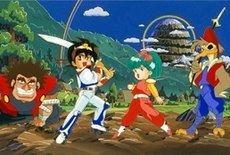7.2 /10 1 Votes7.2
7.5/10 IMDb Written by Yoshimasa Takahashi Studio Sunrise Final episode date 31 March 1989 | 7.1/10 MyAnimeList Music by Hayato Kanbayashi First episode date 15 April 1988 | |||||||||||||||||||||||||||||||||
 | ||||||||||||||||||||||||||||||||||
Produced by Takayuki YoshiiYuko SagawaHibiki Ito Original network Nippon TVBandai Channel Network Nippon Television Network System Program creators Sunrise, Nippon TV, Asatsu-DK Cast Similar Madō King Granzort, Matchless Raijin‑Oh, Cho Mashin Hero Wat, Haō Taikei Ryū Knight, Mashin Hero Wataru 2 | ||||||||||||||||||||||||||||||||||
Mashin Hero Wataru (魔神英雄伝ワタル, Mashin Eiyūden Wataru) is a comedy/adventure Super Robot multimedia franchise originally consisting of 45 episode anime series created by Sunrise first aired on April 15, 1988, replacing the 17:00–17:30 timeslot used for Transformers: The Headmasters. Sunrise credited "Hajime Yatate" for the storyline and Shuji Iuchi directed the series. The series employs a kinetic visual gag style, often employing characters running with their feet over their shoulders derived from Sunrise's previous Super Robot anime series Choriki Robo Galatt.
Contents

Story

The story is about a 9-year-old boy named Wataru Ikusabe (戦部 ワタル, Ikusabe Wataru) who is magically transported to a magical realm by a dragon. This realm is called Soukaizan (創界山, Sōkaizan), which he is supposed to save from an evil, demonic ruler.

The series incorporates many elements of RPG games including dungeon levels and quests for mystical objects. Soukaizan itself is represented as a series of tiered platforms each floating above the one beneath it in a rough pyramid shape. In order to progress to the next tier where he will meet the series' ultimate villain, the show's heroes must complete some task on the one beneath. In addition to these, he has to defeat the ruler of each level along with his many henchmen. Each level he completes, rejuvenates one color of the gray rainbow over Soukaizan.
In his quest to save the realm, Wataru manages to transform a clay sculpture into a somewhat autonomous and small Super Robot. He also befriends many of the Soukaizan natives, and forms some very strong friendship bonds. The term Sou-kai-zan can be broken down to its three parts: "Sou" (creation), "Kai" (realm, space, world, or universe), and "Zan" (hill or mountain), representing the pyramid shape of the world's level.
Cast
Interpretations
The title of the show is a pun. The super-deformed mecha of the series are called "mashin". While written with the kanji for "demon" and "god", "mashin" is also a Japanese loanword for "machine".
Wataru and his friends Shibaraku and Himiko each represent different elements of ancient Japan: Wataru with his magatama and association with dragons represents the pre-Yamato Watari clan. Shibaraku represents samurai. Himiko represents ninja.
Cultural impact
The anime series was a huge hit in Japan, later being imported into Taiwan, Mainland China, and Hong Kong (the latter was shown on TVB Jade). Chinese translations were provided. The show became one of the most famous Japanese anime shows in China during the mid-1990s.
Spinoffs
The franchise has spawned three TV series (Mashin Eiyuuden Wataru, Mashin Eiyuuden Wataru 2, Chou Mashin Eiyuuden Wataru), four radio shows, five OVAs, five novels, five video games, and assorted other merchandise. One of the video games was the original pack-in game for the TurboGrafx-16, and was renamed in the U.S as Keith Courage in Alpha Zones.
Wataru's success prompted Bandai to copy the super-deformed mecha and multi-tiered world concepts in a science fiction setting with Sunrise's 1989 Madō King Granzort TV series.
In the premise of the Japanese anime, Brave Story is a novel created more than a decade later featuring a young boy named Wataru, who is transported to an RPG-like mystical realm. However that novel is not based on nor to be confused with this series.
Staff
Director: Hideharu Iuchi
Additional Directors: Michio Fukuda, Masamitsu Hidaka, Nobuhiro Kondo, Katsuoshi Yatabe, Yutaka Kagawa
Screenwriter: Yoshiaki Takahashi, Ryosuke Takahashi, Hiroyuki Kawasaki, Takao Koyama, Hiroko Naka
Design: Toyoo Ashida, Kazunori Nakazawa
Animator: Toyoo Ashida
Music: Junichi Kanezaki, Satoshi Kadokura
Soundtrack
Wataru
Opening: "Step" by achi-achi
Ending: "Achi-achi Adventure" by achi-achi
Wataru 2:
Opening 1: "Step by Step" by Takahashi Yumiko
Ending 1: "Kimi ni Tomaranai - MY GIRL, MY LOVE" by Takahashi Yumiko
Opening 2: "Fight" by Takahashi Yumiko
Ending 2: "Niji no Kanata" by Takahashi Yumiko
Wataru (3rd TV Series: Super Demon Warrior)
Opening 1: "Hitotsu no Haato de; With One Heart" by Hitomi Mieno
Ending 1: "BOYS BE AMBITIOUS" by Hitomi Mieno
Opening 2: "POWER OF DREAM" by Hitomi Mieno
Ending 2: "Ganbatte" by Hitomi Mieno
